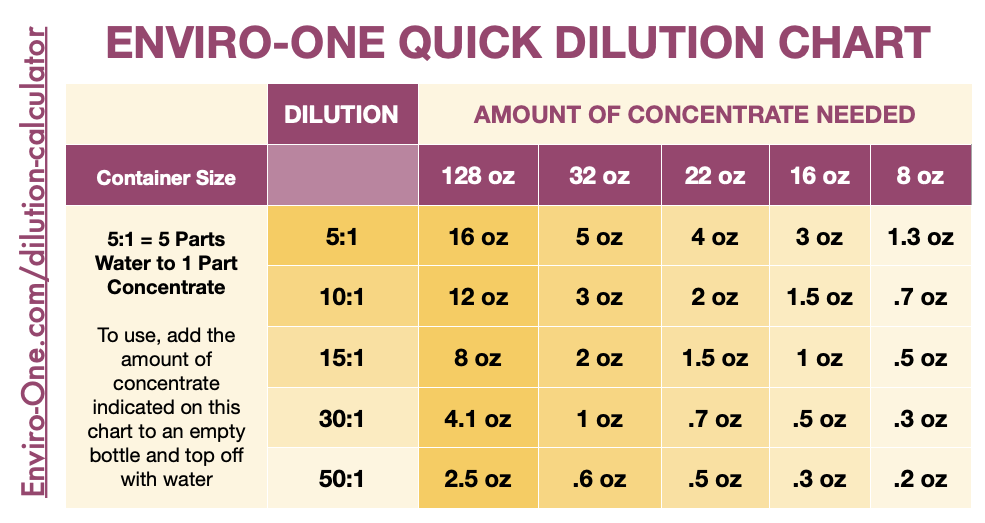LIQUID DILUTION CALCULATOR
-
Select options This product has multiple variants. The options may be chosen on the product page
-
Select options This product has multiple variants. The options may be chosen on the product page
-
Select options This product has multiple variants. The options may be chosen on the product page
Dilution Calculator Chart
The dilution calculator will help you calculate the ratio you need for your desired cleaning solution or use the quick dilution chart on the right.

Example Dilution Ratios
Understanding Liquid Dilution Ratios: A Guide to Effective Cleaning
When it comes to cleaning, achieving the right balance between cleaning agents and water is crucial. Liquid dilution ratios play a significant role in determining the effectiveness of cleaning solutions. Dilution ratios refer to the ratio of cleaning product to water used to create the desired cleaning solution. With Enviro-One, our concentrated, eco-friendly soap, getting these ratios right means powerful cleaning with less waste. Understanding and using the appropriate dilution ratios can result in efficient and cost-effective cleaning outcomes. Let’s explore the importance of liquid dilution ratios and how they can be applied effectively.
Why Dilution Ratios Matter
1. Cost-Effectiveness: Proper dilution ratios help maximize the value of cleaning products. Most cleaning agents are highly concentrated and intended to be diluted before use. Enviro-One, for example, is designed to stretch further with proper dilution—one 16 oz bottle can yield dozens of cleaning solutions. By diluting the product according to the recommended ratio, you can extend its usage and save money in the long run.
2. Safety: Dilution ratios are essential for ensuring safety during cleaning. Some cleaning agents may contain potent chemicals that can be harmful if used undiluted. Enviro-One’s non-toxic formula minimizes risks, but diluting it properly ensures safe, worry-free use on any surface. Diluting them properly reduces the risk of skin irritations, respiratory problems, and chemical accidents.
3. Cleaning Efficiency: The right dilution ratio ensures optimal cleaning performance. Too much cleaning agent can leave behind residue or cause streaks, while too little may result in ineffective cleaning. Enviro-One’s powerful formula, when diluted correctly, cuts through grease and grime without residue—perfect for home or professional use. Diluting the product properly helps strike the right balance, allowing the cleaning solution to work effectively.
Example Dilution Ratios
To better understand liquid dilution ratios, let’s consider some example dilutions for different quantities of water using Enviro-One soap:
| Total Liquid (oz) | Dilution Ratio | Enviro-One (oz) | Water (oz) |
|---|---|---|---|
| 128 | 10:1 | 11.2 | 116.8 |
| 64 | 10:1 | 5.6 | 58.4 |
| 32 | 10:1 | 2.8 | 29.2 |
| 16 | 10:1 | 1.4 | 14.6 |
| 8 | 10:1 | 0.7 | 7.3 |
These examples show how Enviro-One can be diluted for everyday cleaning tasks. Want to try it? Shop Enviro-One Now and see the difference a concentrated, eco-friendly soap can make! Remember to refer to the instructions provided by the cleaner manufacturer for the recommended dilution ratios specific to the product you are using.
Tips for Effective Use of Dilution Calculator Ratios
1. Read the Instructions: Always follow the instructions provided by the cleaning product manufacturer. For Enviro-One, check our label or use this calculator to find the perfect ratio for your task. They will specify the recommended dilution ratios for different cleaning tasks and surfaces.
2. Measure Accurately: Use measuring tools such as measuring cups or scales to ensure precise measurements. Accuracy in dilution ratios is essential for achieving consistent cleaning results with Enviro-One’s concentrated formula.
3. Start with a Small Batch: When using a cleaning product for the first time, start with a smaller batch to test the effectiveness of the dilution ratio. Try Enviro-One with an 8 oz mix to see how it tackles dirt effortlessly. This allows you to make adjustments if necessary before proceeding with larger cleaning tasks.
4. Adjust as Needed: Depending on the level of dirt, stains, or specific cleaning requirements, you may need to adjust the dilution ratio. Enviro-One works great at 10:1 for general cleaning, but try 5:1 for tough grease—find your ideal mix with our calculator! Follow the product instructions and make necessary modifications to ensure the desired cleaning outcome.
5. Label and Store Diluted Solutions: If you plan to store the diluted cleaning solution for future use, label the container with the dilution ratio and date of preparation. Enviro-One’s stable formula stays effective when stored properly—grab a bottle today to start mixing! Properly storing the solution will help maintain its effectiveness over time.
Dilution Calculator Guidelines
Understanding liquid dilution ratios is essential for effective and efficient cleaning. With Enviro-One, diluting our eco-friendly soap according to the recommended ratios ensures cost-effectiveness, safety, and unbeatable cleaning results. By following the provided guidelines and measuring accurately, you can achieve the desired cleaning outcome while maximizing the value of your cleaning products. Ready to clean smarter? Get Enviro-One Now and use our calculator to mix the perfect solution!
Shop Enviro-One Now!


